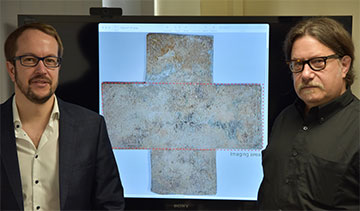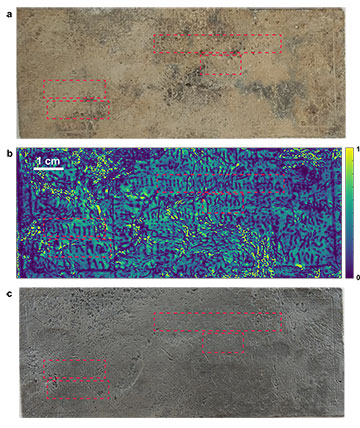
David Citrin (right) and Alexandre Locquet of Georgia Tech-Lorraine stand in front of an image of the 16th-century funerary cross from their study. [Image: N. Jacquet, Georgia Tech-Lorraine, France]
Corrosion on lead art and historical objects can hide important details that help historians understand the stories behind these pieces from the past. Unfortunately, noninvasive imaging with conventional optical frequencies does not work with lead objects—X-rays, for example, are absorbed by the lead, while infrared light reflects off of the corrosive layers. Another option, chemical removal of the corroded material, can damage delicate items.
Now, researchers in France and the United States report a new noninvasive imaging method that combines broadband terahertz imaging with digital signal processing to safely reveal details underneath the corrosion on lead artifacts (Sci. Rep., doi: 10.1038/s41598-022-06982-2). In a demonstration of the technique, the team revealed a previously unreadable portion of the New Testament “Lord’s Prayer” on a 16th-century lead funerary cross from France.
Ultimately, the research team writes that the method could provide “unprecedented information for digital acquisition and documentation” for archaeological studies as well as industrial applications like detecting damage on airplane fuselage. The multidisciplinary team led by David Citrin included experts in imaging, chemistry, art history and conservation, and computer science from the Georgia Institute of Technology in the United States and Georgia Tech-Lorraine and the Musée Charles-de-Bruyères in France.
Terahertz fills the imaging gap
Lead funerary crosses are typically engraved with prayers or information about the deceased. The cross used in the new study is thought to be from the 16th century and was excavated from a burial plot in Remiremont, France, in 1843. Layers of surface corrosion made the engraving almost completely illegible.
Citrin’s group at Georgia Tech-Lorraine specializes in non-destructive imaging techniques that reveal an object’s hidden layers without changing or damaging their original form (see “Cultural Artifacts in Terahertz Light,” OPN, March 2018). So when Aurélien Vacheret, director of the Musée Charles-de-Bruyères, presented Citrin’s group with the corroded lead cross in question, the researchers chose noninvasive single-cycle broadband terahertz pulsed imaging in reflection mode to obtain multispectral images of the obscured engravings on its surface.
Unlike photons from radio, visible, infrared and X-ray regions, broadband terahertz pulses can penetrate through the corrosion products of lead as well as bounce off the engraved surface of the lead cross. And, unlike X-rays, terahertz rays are non-ionizing, making them safer for humans as well as less damaging to delicate artifacts.
Revealing the hidden inscription
To look beneath the corrosion on the lead cross, the researchers first used a commercial terahertz scanner to deliver short and fast broadband pulses (60 GHz to 3 THz) every 0.2 mm along the horizontal bar of the cross. They created 3D multispectral images of surface and sub-surface features by measuring radiation reflectance from six different frequency bands.
Comparison of the inscription on the original lead cross before corrosion removal (top), the final terahertz image after post-processing (middle) and the cross after corrosion removal (bottom). [Image: J. Dong et al. “Revealing inscriptions obscured by time on an early-modern lead funerary cross using terahertz multispectral imaging,” Sci. Rep. 12, 3429 (2022), doi: 10.1038/s41598-022-06982-2 (CC BY 4.0)] [Enlarge image]
They found that the higher frequency bands revealed features associated with the cross engravings—however, the resulting 3D images were not detailed enough to make the engravings legible. By incorporating the low-frequency-band data into their unique image post-processing chain, they were able to enhance the visibility of the inscriptions.
After computerized image enhancement, the researchers could read several Latin words and phrases belonging to the Pater Noster, commonly called Our Father or the Lord’s Prayer, on the cross’s surface.
Better than electrochemical cleaning
To check their work, the researchers was given permission by the museum to electrochemically remove the corrosion from the lead cross. They found that their terahertz imaging and post-processing chain revealed engraving details that were not visible on the cleaned cross.
“Our approach enabled us to read a text that was hidden beneath corrosion, perhaps for hundreds of years,” said Alexandre Locquet of Georgia Tech-Lorraine in a press release. “Clearly, approaches that access such information without damaging the object are of great interest to archaeologists.”

